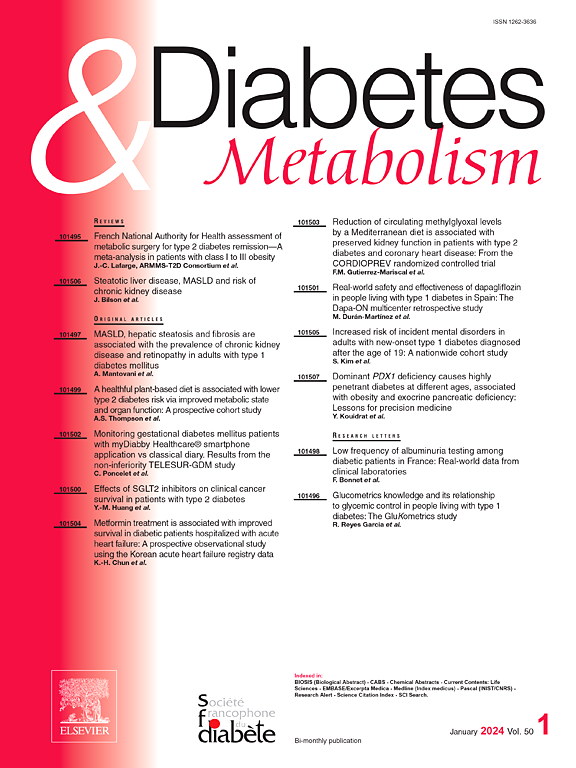Ketoacidosis associated with type 2 sodium-glucose cotransporter inhibitors (SGLT2i) in patients aged 65 and older: Evidence from the French national pharmacovigilance database
IF 4.7
2区 医学
Q1 ENDOCRINOLOGY & METABOLISM
引用次数: 0
Abstract
Background
Sodium-glucose co-transporter-2 inhibitors (SGLT2i) have been widely used in the management of type 2 diabetes, with proven cardiovascular and renal benefits. However, their use has been associated with a risk of diabetic ketoacidosis (DKA).
Aim
This study aims to describe the characteristics of DKA cases associated with SGLT2i use in patients aged 65 and over, based on data from the French pharmacovigilance database.
Methods
A retrospective analysis was conducted on all cases of DKA reported with SGLT2i in patients aged 65 years and older. Cases were retrieved from 2020 onward; 55 were analyzed. Patient characteristics, drug exposure, adverse drug reaction (ADR) reports, hospitalization details, and precipitating factors were examined.
Results
Median patient age was 74.0 years (IQR: 69.0; 77.5), with a predominance of males (63.4 %). The median Charlson comorbidity index was 8.0 (IQR: 6.0; 10.0), and polypharmacy was common, with a median of nine drugs per patient. Infections (36.4 %), dehydration (20.0 %), and fasting (18.2 %) were the main precipitating factors. All cases required hospitalization, with 36.4 % admitted to an intensive care unit (ICU). Among ICU patients, 35.0 % required orotracheal intubation and/or vasopressor therapy. One case (1.8 %) resulted in death. Factors significantly associated with ICU admission included younger age (71.3 vs. 75.4 years, P = 0.009), lower pH at admission (P = 0.003), and infection as a precipitating factor (P = 0.007).
Conclusion
This study highlights the clinical characteristics and risk factors of SGLT2i-associated DKA in older adults. Infections and severe acidosis were key predictors of ICU admission. The findings underscore the importance of careful patient selection and monitoring to mitigate DKA risk in older patients receiving SGLT2i therapy.
65岁及以上患者与2型钠-葡萄糖共转运蛋白抑制剂(SGLT2i)相关的酮症酸中毒:来自法国国家药物警戒数据库的证据
背景:钠-葡萄糖共转运蛋白-2抑制剂(SGLT2i)已被广泛应用于2型糖尿病的治疗,并被证实对心血管和肾脏有益处。然而,它们的使用与糖尿病酮症酸中毒(DKA)的风险有关。目的:本研究旨在根据法国药物警戒数据库的数据,描述65岁及以上患者使用SGLT2i相关的DKA病例的特征。方法:回顾性分析65岁及以上DKA合并SGLT2i的病例。从2020年起检索病例;分析55例。检查患者特征、药物暴露、药物不良反应(ADR)报告、住院细节和促成因素。结果:患者中位年龄为74.0岁(IQR: 69.0; 77.5),男性居多(63.4%)。Charlson合并症指数中位数为8.0 (IQR: 6.0; 10.0),多种用药较为常见,平均每位患者使用9种药物。感染(36.4%)、脱水(20.0%)和空腹(18.2%)是主要的诱发因素。所有病例都需要住院治疗,其中36.4%住进了重症监护病房。在ICU患者中,35.0%需要经气管插管和/或血管加压治疗。1例(1.8%)死亡。与ICU住院显著相关的因素包括年龄较小(71.3岁vs. 75.4岁,P = 0.009),入院时pH值较低(P = 0.003),感染是诱发因素(P = 0.007)。结论:本研究突出了老年人sglt2i相关DKA的临床特点和危险因素。感染和严重酸中毒是ICU住院的关键预测因素。研究结果强调了在接受SGLT2i治疗的老年患者中,谨慎的患者选择和监测对于降低DKA风险的重要性。
本文章由计算机程序翻译,如有差异,请以英文原文为准。
求助全文
约1分钟内获得全文
求助全文
来源期刊

Diabetes & metabolism
医学-内分泌学与代谢
CiteScore
12.00
自引率
4.20%
发文量
86
审稿时长
13 days
期刊介绍:
A high quality scientific journal with an international readership
Official publication of the SFD, Diabetes & Metabolism, publishes high-quality papers by leading teams, forming a close link between hospital and research units. Diabetes & Metabolism is published in English language and is indexed in all major databases with its impact factor constantly progressing.
Diabetes & Metabolism contains original articles, short reports and comprehensive reviews.
 求助内容:
求助内容: 应助结果提醒方式:
应助结果提醒方式:


